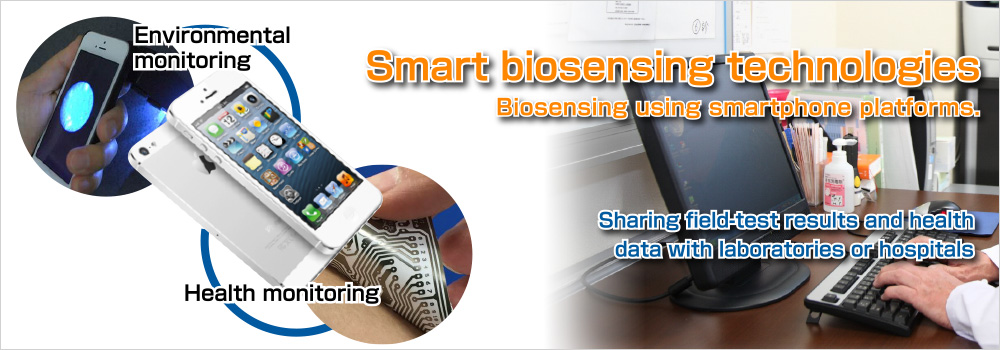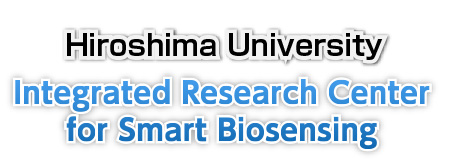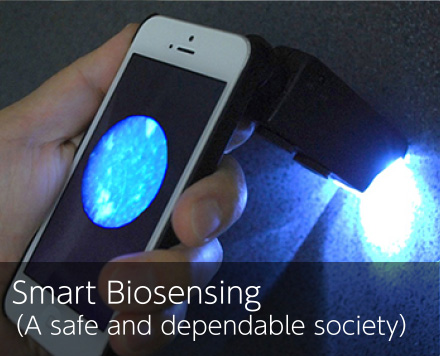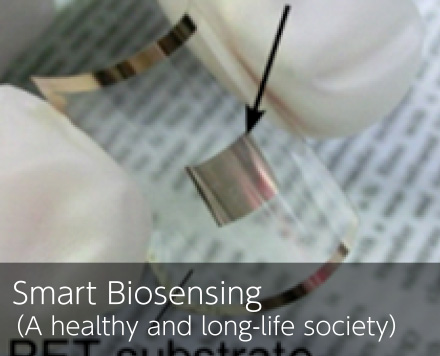
Our mission
There is now a need for portable and wearable biosensors that can collect data from the environment around us and from our own bodies. At present, the number of smartphones and other compact telecommunications devices has grown to 6.5 billion worldwide, offering the greatest potential as a portable biosensor infrastructure. In order to develop biosensors that use smartphones as the platform, it is necessary to accelerate the development of smart biosensing technologies that combine biotechnology, nano-optical devices, and flexible electronics. By bringing together unique Hiroshima University strengths such as advanced interdisciplinary research conducted at the Graduate School of Advanced Sciences of Matter, and the cutting-edge LSI manufacturing technologies and super clean room belonging to the Research Institute for Nanodevice and Bio Systems, this center seeks to contribute to building a safe, dependable, healthy, and long-life society.
Past achievements
- Our researchers were among the first in the world to acquire silicon binding proteins as an interface control technology for organic proteins and inorganic silicon materials. By applying this technology to silicon nano-devices, we succeeded in developing a semiconductor biosensor that can detect minute amounts of antigens (FY 2006 – 2008 Special Coordination Fund for Promoting Science and Technology, Creation of Innovation Centers for Advanced Interdisciplinary Research Areas Program).
- By engineering a unique protein probe that binds to asbestos, and combining it with optical technologies, we succeeded in creating a method for fluorescent visualization of asbestos (awarded the FY 2012 Commendation for Science and Technology by the Minister of Education, Culture, Sports, Science and Technology).
- We succeeded in fabricating a monocrystalline silicon transistor on a plastic substrate, and are developing flexible electronics for collecting health data (Electron mobility 609 cm2 V-1s-1, technology possessed exclusively by Hiroshima University, Funding Program for Next Generation World-Leading Researchers (NEXT Program)).
- We successfully developed the world’s smallest Yagi antenna using nano-optical device technologies (Nature Photonics, 2010).
Methods and core members
The Integrated Research Center for Smart Biosensing was created to combine revolutionary bio-system technologies with nano-optical device and flexible electronics technologies in order to develop and fabricate biosensors that can be connected to smartphones. Using the micro-machining technologies of the Hiroshima University Research Institute for Nanodevice and Bio Systems (Ministry of Education, Culture, Sports, Science and Technology Nanotechnology Platform), we are bringing these technologies together on the manufacturing level.
The leader of the research center is Professor Akio Kuroda (Distinguished Professor, biotechnology) of the Department of Molecular Biotechnology in the Graduate School of Advanced Sciences of Matter. Other core members are Professor Yutaka Kadoya (optical devices) of the Department of Quantum Matter, and Professor Seiichiro Higashi (flexible electronics) of the Department of Semiconductor Electronics & Integration Science, both in the same graduate school.
Future promise of the research center
This project focuses on the research areas that include biosensing technologies, nano-optical device technologies, and semiconductors – areas where Hiroshima University researchers have achieved much success in the past. It aims for a large ripple effect that will contribute to solving problems in the environmental and medical fields, and also for the development of interdisciplinary research staff who have a strong understanding of multiple academic disciplines. The Integrated Research Center for Smart Biosensing is an incubator for nurturing university-level fusion of bioscience, material science, information science and nano-electronics in order to produce revolutionary new technologies.
For developing practical applications, the center also conducts technology transfers and provides support for technology development by industry, and is launching new interdisciplinary and applied research projects.
Supporting Companies
Hamamatsu Photonics K.K.
OPTO SCIENCE, INC.
Siliconbio inc.




